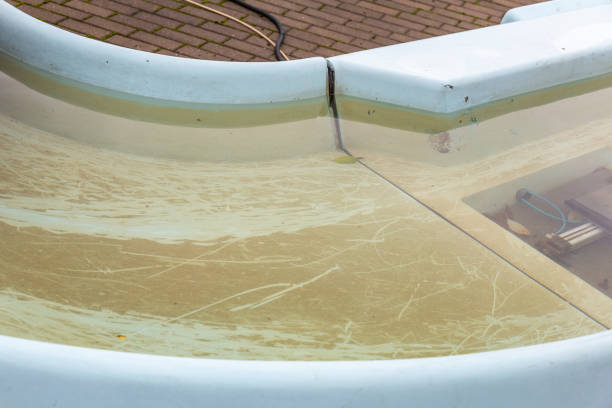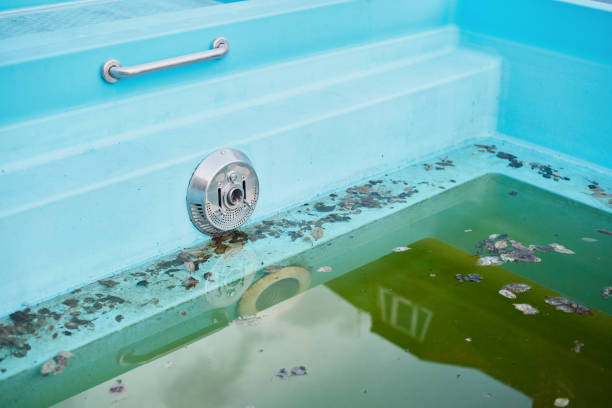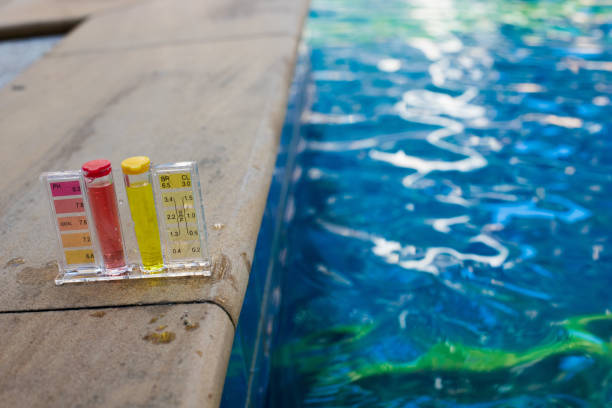Introduction:
Maintaining a pristine pool is the epitome of luxury and relaxation, but sometimes, unsightly stains can mar its beauty. Understanding the presence of metals in pool water is crucial for keeping those shimmering blue waters crystal clear. In this guide, we’ll delve into the nuances of Metals in Pool Water: Identifying, Preventing, and Treating Stains, providing insights on how to identify, prevent, and effectively treat these pesky stains.

Identifying Metals in Pool Water:
Before tackling stains, it’s essential to identify the culprits lurking beneath the surface. Metals such as iron, copper, and manganese are common offenders, often introduced into pool water through various sources like metal plumbing, algaecides, or even from the water source itself. Regular testing of pool water for metal content is imperative to catch these troublemakers early on and prevent staining.

Preventing Metal Stains:
Prevention is always better than cure, especially when it comes to maintaining the pristine allure of your pool. Several measures can be taken to prevent Metals in Pool Water: Identifying, Preventing, and Treating Stains. Using a quality metal sequestrant is one such preventive measure; these products bind to metal ions, preventing them from causing stains. Additionally, maintaining proper water balance and ensuring that pH levels are within the recommended range can help mitigate metal staining.

Regular maintenance routines, including skimming, brushing, and vacuuming, also play a vital role in preventing metal stains. By removing debris and contaminants from the pool water promptly, you reduce the chances of metals oxidizing and causing unsightly blemishes on pool surfaces.

Treating Metal Stains:
Despite our best efforts, metal stains can still occur. When faced with these stubborn marks, it’s crucial to address them promptly and effectively. Several methods can be employed for treating Metals in Pool Water: Identifying, Preventing, and Treating Stains. One popular approach is the use of metal stain removers, specially formulated to dissolve and lift metal deposits from pool surfaces.

Another effective treatment method involves using ascorbic acid (vitamin C) to reduce metal stains. Ascorbic acid reacts with metal ions, breaking them down and restoring the pool’s pristine appearance. However, it’s essential to follow manufacturer instructions carefully and perform a thorough water balance check after treatment to prevent any adverse effects.

In some cases, particularly severe stains may require professional intervention. Pool maintenance experts possess the expertise and specialized equipment necessary to tackle stubborn metal stains effectively. By entrusting the task to professionals, you can ensure that your pool is restored to its former glory safely and efficiently.

Conclusion:
Maintaining a flawless pool requires vigilance and proactive measures to combat the menace of metal stains. By understanding the dynamics of Metals in Pool Water: Identifying, Preventing, and Treating Stains, you empower yourself to keep your pool pristine and inviting year-round. Whether through preventive strategies or targeted treatments, staying one step ahead ensures that your pool remains a haven of relaxation and enjoyment for years to come.

Reference:
- “Metal Stains in Swimming Pools: Causes, Prevention, and Treatment.” Swim University, www.swimuniversity.com/metal-stains-in-swimming-pools/.

Your point of view caught my eye and was very interesting. Thanks. I have a question for you.
Your point of view caught my eye and was very interesting. Thanks. I have a question for you.
Can you be more specific about the content of your article? After reading it, I still have some doubts. Hope you can help me.
Your article helped me a lot, is there any more related content? Thanks! https://www.binance.com/join?ref=P9L9FQKY
Thank you for your sharing. I am worried that I lack creative ideas. It is your article that makes me full of hope. Thank you. But, I have a question, can you help me?
Thanks for sharing. I read many of your blog posts, cool, your blog is very good.
Thanks for sharing. I read many of your blog posts, cool, your blog is very good. https://www.binance.com/join?ref=P9L9FQKY
I don’t think the title of your article matches the content lol. Just kidding, mainly because I had some doubts after reading the article. https://www.binance.info/en-ZA/register?ref=JHQQKNKN
I don’t think the title of your article matches the content lol. Just kidding, mainly because I had some doubts after reading the article.
I don’t think the title of your article matches the content lol. Just kidding, mainly because I had some doubts after reading the article. gratis binance-konto
Thank you for your sharing. I am worried that I lack creative ideas. It is your article that makes me full of hope. Thank you. But, I have a question, can you help me?
Thank you for your sharing. I am worried that I lack creative ideas. It is your article that makes me full of hope. Thank you. But, I have a question, can you help me?
I don’t think the title of your article matches the content lol. Just kidding, mainly because I had some doubts after reading the article.
Your article helped me a lot, is there any more related content? Thanks!
Can you be more specific about the content of your article? After reading it, I still have some doubts. Hope you can help me.
Thanks for sharing. I read many of your blog posts, cool, your blog is very good.
Your article helped me a lot, is there any more related content? Thanks! https://www.binance.info/en-IN/register?ref=UM6SMJM3
**mindvault**
mindvault is a premium cognitive support formula created for adults 45+. It’s thoughtfully designed to help maintain clear thinking
I don’t think the title of your article matches the content lol. Just kidding, mainly because I had some doubts after reading the article.
Can you be more specific about the content of your article? After reading it, I still have some doubts. Hope you can help me.
**sugarmute**
sugarmute is a science-guided nutritional supplement created to help maintain balanced blood sugar while supporting steady energy and mental clarity.
**glpro**
glpro is a natural dietary supplement designed to promote balanced blood sugar levels and curb sugar cravings.
**prostadine**
prostadine is a next-generation prostate support formula designed to help maintain, restore, and enhance optimal male prostate performance.
**prodentim**
prodentim an advanced probiotic formulation designed to support exceptional oral hygiene while fortifying teeth and gums.
**nitric boost**
nitric boost is a dietary formula crafted to enhance vitality and promote overall well-being.
**glucore**
glucore is a nutritional supplement that is given to patients daily to assist in maintaining healthy blood sugar and metabolic rates.
**vittaburn**
vittaburn is a liquid dietary supplement formulated to support healthy weight reduction by increasing metabolic rate, reducing hunger, and promoting fat loss.
**synaptigen**
synaptigen is a next-generation brain support supplement that blends natural nootropics, adaptogens
**mitolyn**
mitolyn a nature-inspired supplement crafted to elevate metabolic activity and support sustainable weight management.
**zencortex**
zencortex contains only the natural ingredients that are effective in supporting incredible hearing naturally.
**yusleep**
yusleep is a gentle, nano-enhanced nightly blend designed to help you drift off quickly, stay asleep longer, and wake feeling clear.
**wildgut**
wildgutis a precision-crafted nutritional blend designed to nurture your dog’s digestive tract.
**breathe**
breathe is a plant-powered tincture crafted to promote lung performance and enhance your breathing quality.
**energeia**
energeia is the first and only recipe that targets the root cause of stubborn belly fat and Deadly visceral fat.
**pinealxt**
pinealxt is a revolutionary supplement that promotes proper pineal gland function and energy levels to support healthy body function.
**boostaro**
boostaro is a specially crafted dietary supplement for men who want to elevate their overall health and vitality.
**prostabliss**
prostabliss is a carefully developed dietary formula aimed at nurturing prostate vitality and improving urinary comfort.
**potent stream**
potent stream is engineered to promote prostate well-being by counteracting the residue that can build up from hard-water minerals within the urinary tract.
**hepatoburn**
hepatoburn is a premium nutritional formula designed to enhance liver function, boost metabolism, and support natural fat breakdown.
**hepato burn**
hepato burn is a potent, plant-based formula created to promote optimal liver performance and naturally stimulate fat-burning mechanisms.
**flow force max**
flow force max delivers a forward-thinking, plant-focused way to support prostate health—while also helping maintain everyday energy, libido, and overall vitality.
**prodentim**
prodentim is a forward-thinking oral wellness blend crafted to nurture and maintain a balanced mouth microbiome.
**cellufend**
cellufend is a natural supplement developed to support balanced blood sugar levels through a blend of botanical extracts and essential nutrients.
**revitag**
revitag is a daily skin-support formula created to promote a healthy complexion and visibly diminish the appearance of skin tags.
**neurogenica**
neurogenica is a dietary supplement formulated to support nerve health and ease discomfort associated with neuropathy.
**sleeplean**
sleeplean is a US-trusted, naturally focused nighttime support formula that helps your body burn fat while you rest.
Thank you, your article surprised me, there is such an excellent point of view. Thank you for sharing, I learned a lot.
I don’t think the title of your article matches the content lol. Just kidding, mainly because I had some doubts after reading the article. https://www.binance.info/cs/register?ref=S5H7X3LP
Thanks for sharing. I read many of your blog posts, cool, your blog is very good.